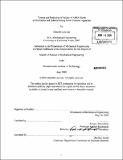Testing and prediction of failure of AHSS sheets at Die Radius and Sidewall using novel fracture apparatus
Author(s)
Issa, Danielle Léa
DownloadFull printable version (48.42Mb)
Other Contributors
Massachusetts Institute of Technology. Dept. of Mechanical Engineering.
Advisor
Tomasz Wierzbicki.
Terms of use
Metadata
Show full item recordAbstract
A new apparatus was constructed to fit the Impact and Crashworthiness Lab's dual actuator custom-made loading frame that has force or position control. The strip is pre-bent into an elbow configuration and fastened by the vertical and horizontal grips. One end of the metal strip is subjected to a predefined constant restraining force, while the other is pulled with a constant velocity to cause a rolling deformation over a prescribed die radius. A series of 40 tests, using TRIP 690 steel, was performed for various combinations of die radius, magnitude of pretension, and die/strip friction. Based on the experimental results, a deformation and failure map was generated, showing ranges of safe forming. Depending on the interplay of different parameters, fracture occurs either on the sidewall or on the die radius, in which case, a close examination of the surface reveals it is slant. Combined theoretical, experimental, and numerical analyses are presented. The present study confirmed previous results published in the literature [1,5] that the pretension needed to fracture a metal strip increases with die radius and tends asymptotically to a constant value. What is new in the present investigation, however, is that this relationship has been quantified for a particular steel of interest for automotive applications. In addition, a method was outlined to predict fracture through finite element simulations, which was lacking in the earlier treatment of a similar problem.
Description
Thesis (S.M.)--Massachusetts Institute of Technology, Dept. of Mechanical Engineering, 2009. Includes bibliographical references (p. 109-110).
Date issued
2009Department
Massachusetts Institute of Technology. Department of Mechanical EngineeringPublisher
Massachusetts Institute of Technology
Keywords
Mechanical Engineering.